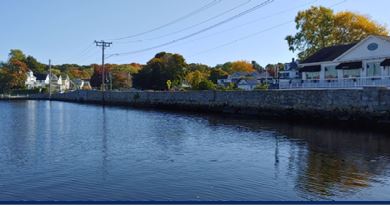Preliminary Engineering Report Holmes Street Seawall –Innovative Design for Climate Resilience
Project Summary
Holmes Street serves as an important collector road within Historic Downtown Mystic connecting local businesses, homes, and points of interest. An approximately 500-foot-long section of Holmes Street from the intersection with Bay Street and extending southwest past the intersections with Frazier Street is supported by a seawall along the western shore of the Mystic River. The existing seawall is in poor condition due to the age of the structure and scour due to rise in the water level and severe weather events.
Product
Preliminary Engineering Report Holmes Street Seawall –Innovative Design for Climate Resilience
June, 2023
Project Description
The Town of Stonington was awarded a Connecticut Institute for Resilience & Climate Adaptation (CIRCA) grant to identify sustainable and resilient solutions to repair or replace the seawall. The solutions proposed are specific to the project location, but the results from this study are intended to be transferable to other communities facing similar climate challenges from increasing storm surge and sea level rise. Weston & Sampson was selected as the technical consultant to perform this study, which included evaluating existing conditions through site visits, survey, subsurface explorations, and structural evaluations; assessing coastal flood risk and resilience alternatives; preparing preliminary engineering alternatives with cost estimates; and recommending next steps to refine alternatives and advance through construction. Downtown Mystic is subject to current and future flood risk, and Holmes Street has flooded in the past under storm events. Flooding extends beyond the limits of the Holmes Street Seawall, which means that solutions proposed for this site will not be independently effective in mitigating flood risk. The resilience considerations for the site emphasize reducing the consequences from flood events (both to the infrastructure as well as community), adaptability of the solution, potential for creating social and economic value, and environmental benefits. Weston & Sampson developed several preliminary resilience concepts that can be integrated with structural alternatives for repairing or replacing the wall. The concepts are not mutually exclusive and may be combined as final design advances. Three structural alternatives were developed based on the results of this study: 1. rehabilitation of the existing seawall by installing sheet piling 2. complete wall replacement with soldier pile and lagging wall 3. complete wall replacement with conventional cast-in-place concrete retaining wall. Each of these alternatives will need to be designed and constructed to be scour resistant and can be integrated with larger regional resilience initiatives, including policy and physical measures. An opinion of probable cost associated with each structural alternative was presented, as well as next steps to advance design, permitting, and construction.
Project Team
Town of Stonington
Weston & Sampson
UConn CIRCA

Topic Areas
This project is a part of the following topical areas: